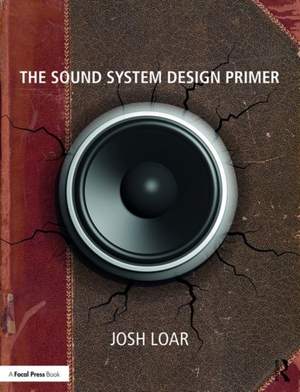The Sound System Design Primer
- Author: Loar, Josh
[This] book can be enjoyed by newcomers and seasoned pros alike. Whether looking to start a career in audio technology, or brush up on your skills, look no further than The Sound Design Primer — More…
Book
$94.50Printed on demand
Contents
- Contents
- Dedication
- List of Figures
- Preface: Why This Book? Who Is This Book For?
- Acknowledgements
- Introduction: What This Book Does, and How It Works
- A Note on Safety
- Part I: What is a Sound System?
- What is a sound system? How does sound itself work? What are the components we need in order to get signal to our audience? Examining the fundamentals of sound, and all the standard components of a contemporary sound system.
- Section 1: Basics
- Chapter 1: The Four Standard Elements of the Analog Sound System
- Chapter 2: The Four Standard Elements of the Digital Sound System
- Chapter 3: What Is Sound?-Part 1: Acoustic Version
- Chapter 4: What Is Sound?-Part 2: Electric Version
- Chapter 5: What Is Sound?-Part 3: Digital Version
- Section 2: Inputs
- Chapter 6: Microphones (Wired)
- Chapter 7: Microphones (Wireless)
- Chapter 8: Direct Inputs (Instruments, Turntables, Etc.)
- Chapter 9: Playback Devices and Systems
- Section 3: Processing
- Chapter 10: Preamplifiers and Mixing Consoles
- Chapter 11: Effects-Part 1: Creative and Mixing Effects
- Chapter 12: D.S.P.: Digital Signal Processing
- Chapter 13: Effects-Part 2: System Calibration Effects
- Section 4: Amplification
- Chapter 14: Power Math
- Chapter 15: Power Amplifiers (plus a Note on Power Conditioners,
- Uninterruptible Power Supplies, and Distros)
- Section 5: Outputs
- Chapter 16: Speakers
- Chapter 17: Monitoring Systems
- Section 6: Computers and Sound
- Chapter 18: Networks and Connectivity
- Chapter 19: Show Control
- Chapter 20: Triggers, Sensors, and Customization
- Section 7: Communication Systems
- Chapter 21: Audio Com Systems
- Chapter 22: Paging Systems
- Chapter 23: Video Com-We Know It's Not Audio, But It's Almost Always Our Job Anyway!
- Section 8: Connections
- Chapter 24: Cable Types and Their Uses
- Part II: How Do You Set Up, Test, and Calibrate a Basic Sound System?
- How do you assemble a sound system? How do you test your gear and troubleshoot problems? Beginning designers often have to do this work themselves, and any designer needs to understand how their system fits together. Examining the installation process.
- Section 9: Installation
- Chapter 25: Signal Flow, from Installation to Verification
- Chapter 26: Testing and Troubleshooting
- Section 10: Calibration
- Chapter 27: Measurement Tools and Systems
- Chapter 28: Measurement Practices, System Calibration and
- Optimization
- Chapter 29: Acoustic Treatments and Other Solutions
- Part III: What Type of Sound System Do You Need?
- What are the special questions that need to be asked in each discipline? What are the differences in expected process? What are the schedules and special terms? Examining different sound system types by discipline.
- Section 11: The Basic Process of System Design
- Chapter 30: Understanding the Source Material
- Chapter 31: Understanding the Venue
- Chapter 32: Understanding the Audience
- Chapter 33: Understanding the Budget and Available Resources
- Chapter 34: Selecting Loudspeakers and Positions (Loudspeaker Modeling)
- Chapter 35: Selecting the Remaining Equipment and Plan for Operation
- Chapter 36: Refining Your Choices
- Section 12: The Different Types of Sound System
- Chapter 37: Concerts, Small Scale
- Chapter 38: Concerts, Large Scale, and Festivals
- Chapter 39: Theater-Straight Plays
- Chapter 40: Theater-Musicals
- Chapter 41: Conventions and Other Multi-Room Live Events
- Chapter 42: Performing Arts Venues and Houses of Worship for Permanent Installation
- Chapter 43: Supermarkets, Airports, and Other Retail Spaces
- Chapter 44: Theme Parks, Cruise Ships, Casinos, and Other Themed Environments
- Chapter 45: Recording/Mixing/Mastering Studios (Project and Commercial) for Music, Film, etc. (Including a brief note on Sound Stages for Visual Media)
- Chapter 46: Corporate Offices, Hotels, Restaurants, and Other Architectural Environments
- Chapter 47: Creative Systems-Multimedia Art Galleries, New Media, New Uses
- Part IV: How Do You Document and Present Your Design?
- What do you need to do in order to ensure you present your work professionally and effectively? Examining the process, from first meeting to final design documents.
- Section 13: Technical Drawing
- Chapter 48: Basic Technical Drawing Standards (Organizing and Labeling, Drawing Setup, Notes on Computer Drafting, etc.)
- Chapter 49: Plan and Elevation Views (including Rack Elevations)
- Chapter 50: System Block Diagrams (Audio, Control, Network Risers)
- Chapter 51: Mounting Details
- Chapter 52: Magic Sheets
- Section 14: Other Technical Documentation
- Chapter 53: Hookups and Workbooks
- Chapter 54: Equipment (Hardware, Cable, RF, IP, etc.) Schedules and Facilities Impact Reports
- Chapter 55: Budget Documents
- Chapter 56: Technical Narratives
- Chapter 57: Presentation Packaging (to Clients, Bidders, and Integrators)
- Section 15: Presenting Your Work to Paying Clients
- Chapter 58: First Presentations
- Chapter 59: Revisions
- Chapter 60: Finalizing and Signing-Off
- Afterword: What Comes Next-A Path Forward for The System Designer
- Bibliography and Further Reading
- Index




